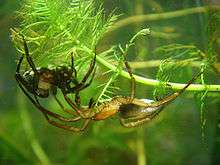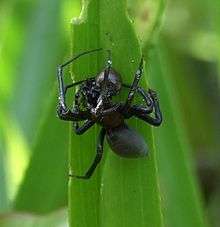Diving bell spider
| Diving bell spider | |
|---|---|
 | |
| Female (on left) and male | |
| Scientific classification | |
| Kingdom: | Animalia |
| Phylum: | Arthropoda |
| Class: | Arachnida |
| Order: | Araneae |
| Family: | Cybaeidae |
| Genus: | Argyroneta Latreille, 1804 |
| Species: | A. aquatica |
| Binomial name | |
| Argyroneta aquatica (Clerck, 1758) | |
| Synonyms[1] | |
|
Araneus aquaticus | |
The diving bell spider or water spider (Argyroneta aquatica) is one of the few species of spider known to live almost entirely under water. It is the only member of the genus Argyroneta. When out of the water, the spider ranges in colour from mid to dark brown, although the hairs on the abdomen give it a dark grey, velvet-like appearance.[2]
Ecology

A. aquatica is found in freshwater ponds and streams in northern and central Europe and northern Asia up to latitude 62°N. As with other spiders it breathes air; when submerged in water, an air bubble is trapped by a dense layer of hydrophobic hairs on its abdomen and legs,[3] giving the abdomen a silvery appearance. The spider lives for about two years in captivity.[3]
A. aquatica is able to remain submerged for prolonged periods of time due to the silk-based structure it constructs in order to retain an oxygen supply, named after the diving bell structure it resembles. The species range in size, although the size of females may be limited as they put more energy into building and maintaining their larger bells.[3] Males are typically more active and 30% larger than females. This size differential favoring males is unusual for spiders, where sexual dimorphism is usually in favour of larger females. Theories suggest that the male's more active hunting style requires greater strength to overcome water resistance and counteract the buoyancy of their mobile air supplies. This larger body size is also associated with longer front legs, shown to affect diving ability and giving the males superiority in diving over the more sessile females.[3]
The spiders prey on aquatic insects and crustaceans such as mosquito larvae and Daphnia.[4] Their bite is quite painful as the fangs can pierce the skin, causing localised inflammation and feverishness.[5] The spiders themselves fall prey to frogs and fish.[6]
Diving bell
The appearance of the diving bell gave rise to the genus name Argyroneta, from the Greek "argyros" (ἄργυρος), meaning "silver", and "neta", a neologism (perhaps for *νητής) derived from the verb "neo" (νέω) "spin", intended to mean "spinner of silver".[7] Both sexes build diving bell webs which are used for digesting prey and molting, although only the female's larger bell is used for mating and raising offspring. Females spend most of their time within their bells, darting out to catch prey animals that touch the bell or the silk threads that anchor it and occasionally surfacing to replenish the air within the web. The bells built by males are typically smaller than females and are replenished less often. It is thought that prior to mating, the male constructs a diving bell adjacent to the female's then spins a tunnel from his bell, breaking into hers to gain entrance.[6] Mating takes place in the female's bell.[8] The female spider then constructs an egg sac within her bell, laying between 30 and 70 eggs.[6]
Diving bells are irregularly constructed sheets of silk and an unknown protein-based hydrogel[9] which is spun between submerged water plants then inflated with air brought down from the surface by the builder. Studies have considered gas diffusion between the diving bell and the spiders’ aquatic environment. The silk, whilst waterproof, allows gas exchange with the surrounding water; there is net diffusion of oxygen into the bell and net diffusion of carbon dioxide out. This process is driven by differences in partial pressure. The production of carbon dioxide and use of oxygen by the spider maintains the concentration gradient, required for diffusion. However, there is net diffusion of nitrogen out of the bell, resulting in a gradually shrinking air bubble which must be regularly replenished by the spider.[4]
Larger spiders are able to produce larger bubbles which have a consequently higher oxygen conductance, but all spiders of this species are able to enlarge their bells in response to increased oxygen demands in low aquatic P(O2) environments. These spiders voluntarily tolerate internal conditions of low oxygen, enlarging their bells with air when the P(O2) drops below 1 kPa; this replenishment process may not need to occur for several days, in some cases.[4] This system has been referred to as "the water spider's aqua-lung of air bubbles", though an aqua-lung lacks gas exchange with the surroundings;[10] this system is more properly regarded as an inorganic form of gill.
References
- ↑ Norman I. Platnick (March 27, 2010). "Fam. Cybaeidae Banks, 1892d: 95". The World Spider Catalog, Version 11.0. American Museum of Natural History. Retrieved August 30, 2010.
- ↑ "Argyroneta aquatica (Clerck 1758) (Water spider)". danmarks-edderkopper.dk. Retrieved 14 September 2015.
- 1 2 3 4 Schütz, D.; Taborsky, M. (2003). "Adaptations to an aquatic life may be responsible for the reversed sexual size dimorphism in the water spider, Argyroneta aquatica" (PDF). Evolutionary Ecology Research. 5 (1): 105–117.
- 1 2 3 Seymour, R. S.; Hetz, S. K. (2011). "The diving bell and the spider: the physical gill of Argyroneta aquatica". J. Exp. Biol.: 2175–2181.
- ↑ Ross Piper (2007), Extraordinary Animals: An Encyclopedia of Curious and Unusual Animals, Greenwood Press.
- 1 2 3 Chandramita Bora. "Water Spider".
- ↑ Thorell, Tord (1869). On European Spiders. Uppsala, Sweden: Royal Society of Upsala. p. 137. Retrieved 2012. Check date values in:
|access-date=(help) - ↑ Schütz, Dolores; Taborsky, Michael (2005). "Mate choice and sexual conflict in the size dimorphic water spider, Argyroneta aquatica (Aranae, Argyronatidae)" (PDF). Journal of Arachnology. 33.
- ↑ Neumann, Dietrich; Kureck, Armin (2013). "Composite structure of silken threads and a protinaceous hydrogel which form the diving bell wall of the water spider Argyroneta aquatica". SpringerPlus. 2 (223). Retrieved 7 August 2015.
- ↑ Flynn, M. R.; Bush, John W. M. (2008). "Underwater breathing: the mechanics of plastron respiration". J. Fluid Mech. Cambridge University Press. 608: 275–296. doi:10.1017/S0022112008002048.
External links
| Wikimedia Commons has media related to Argyroneta aquatica. |
- Diving Bell Spider - Argyroneta aquatica, The BioFresh Cabinet of Freshwater Curiosities.
- Water spider pictures on Arkive.org
- "Water Spider". eb.archive.org. Archived from the original on 2009-11-01. Retrieved 2014-01-25.
- Diving bell spiders use bubble webs 'like gills'